Update: I also have a soy-free corn-free version of my homemade whole grain chicken feed! For easy formulating, download Garden Betty’s Chicken Feed Calculator to manage costs, calculate protein content, and custom mix your feed on the fly.
More than nine years ago, I started mixing my own soy-free, mostly organic, whole grain chicken feed, and it’s still the best feed I could possibly give my hens. (I’ve tried the entire lineup from the feed store.)
The decision to feed a whole grain diet—versus a commercially formulated diet—is a personal one based on what I believe is best for my hens. Luckily, it also turned out to be an economical decision and a benefit to my own diet.
Homemade chicken feed is not as expensive or complicated as you may have thought or been told.
My small flock of hens lays two dozen eggs a week on a DIY diet of whole grains and leafy greens. Their feathers are soft and shiny, their personalities as perky as ever… so I must be doing something right!
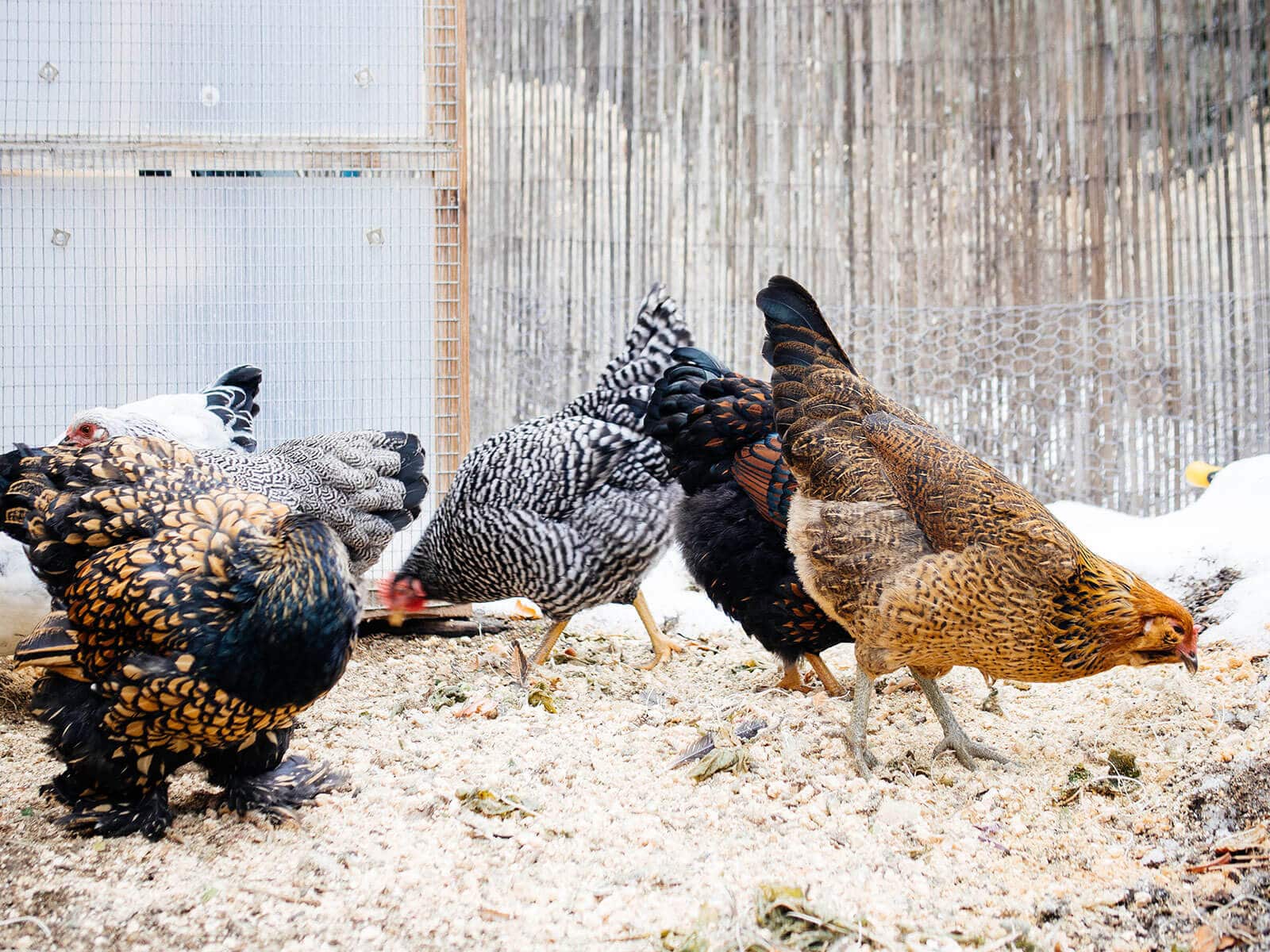
Why should you make your own whole grain chicken feed?
Commercial poultry feed comes in crumble or pellet form, neither of which looks like real food to me. Since real food comes out of my chickens, I want real food to go into them.
Crumbles and pellets are already formulated to contain the nutritional balance that a chicken needs, but the process of cracking, mashing, pressing and/or heating the grains (often times, not even quality grains) causes them to go stale and lose some of their nutritional value—even months before you buy them.
On the other hand, whole grains (which you can pick and choose) retain all of their nutrients.
With a whole grain diet, I’ve noticed that my hens eat less and poop less (as opposed to the crumble diet they started on). This leads me to believe that their bodies are processing the food better and it’s not just passing through them.
Disclosure: Garden Betty earns commissions on purchases made through these links to my affiliated retailers. View my policy.
Is a homemade whole grain diet a complete diet for a chicken?
Like humans, chickens need a diverse diet and sometimes they need a different diet in winter than they do in summer.
The greater variety of grains, legumes, and seeds you can provide your chickens, the healthier and happier they will be.
Layers need at least 16 percent protein and the rest is common sense—not too much fat, not too many carbs, and that last piece of chocolate cake is probably not a good idea. It’s all about balance.
I imagine that people wanting to make their own feed at home are likely also the sort of chicken keepers that let their chickens forage for bugs and weeds, or give their chickens mealworm treats and kitchen scraps. So overall, yes—this is a complete diet.
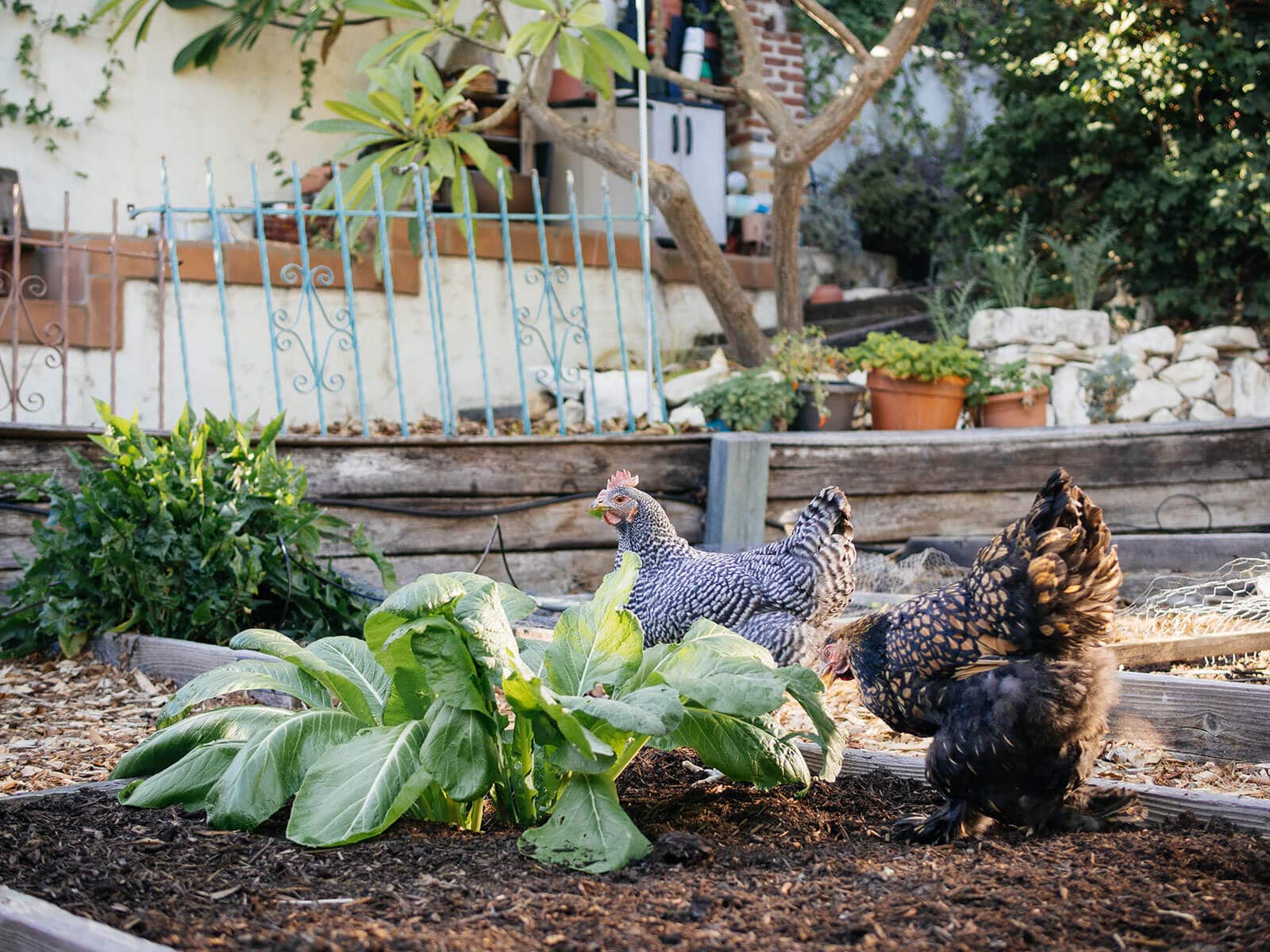
Why should chicken feed be soy-free and organic?
Because of its cheapness, availability, and high amount of protein, soy is a large part of a commercial chicken’s diet. But it’s also an incomplete protein, an unnatural source of food, and a highly processed food.
As with anything highly processed, soy has potentially harmful health effects ranging from vitamin deficiencies to hormone disruptions—especially when consumed in the crazy amounts that our culture does.
Soy is one of the most genetically-modified foods in the world, and it’s included in almost everything we eat. I know I can’t avoid it in my diet, but I can limit my intake of soy by choosing not to feed it to my chickens. You are what you eat.
(A pro-soy study found that soy protein transferred to the egg yolks and tissues of commercial chickens—even commercial “organic” chickens—fed a predominantly soy diet.)
An all-organic feed was originally not as important to me as a soy-free feed. I felt the benefits of a whole grain diet outweighed those of an organic (but processed) diet.
As it turned out, my homemade poultry feed is almost all organic, thanks to bulk purchases from Azure Standard and my local supermarket.
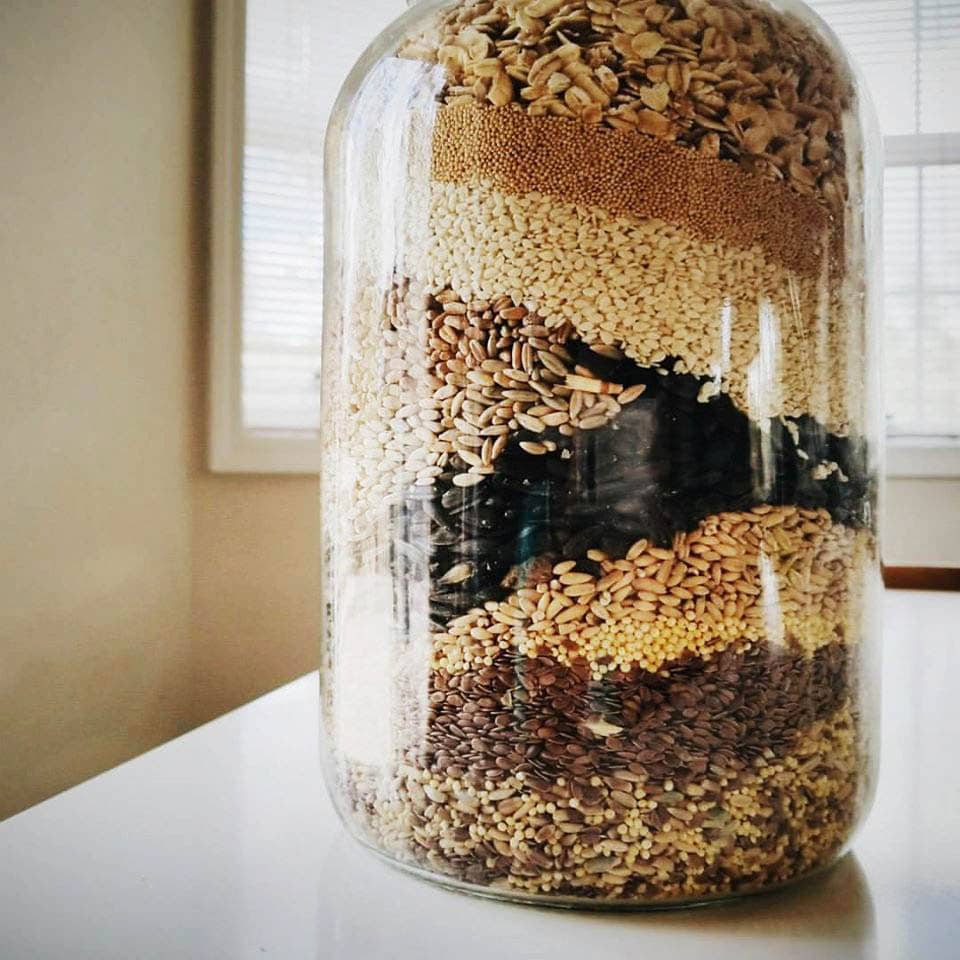
How much does DIY chicken feed cost?
My homemade chicken feed actually costs the same as the commercial poultry feed at my local feed store. This may not be true for everyone, but on the west coast, a premium bag of soy-free, organic layer pellets averages $0.70 per pound.
My soy-free, almost organic, whole grain feed costs $0.69 per pound (and would even be less if I purchased in larger bulk quantities—but I have a small flock and very limited storage).
This isn’t cheap chicken feed by any means, but it’s also not exorbitantly expensive considering the quality ingredients that go into it. You can lower the cost by going in with a fellow chicken-keeper on 50-pound bags of grains, or by using animal-grade ingredients instead of human-grade (which is what you’ll find in feed stores, and they’re perfectly acceptable).
An unexpected advantage of mixing my own feed is that I can share a lot of the grains, legumes, and seeds with my chickens, and I even use some of the same grains in my homemade dog food.
The ingredients are all human grade and mostly organic, and the fact that they can feed the whole household makes buying 10- or 25-pound bags of grains more feasible.
While there was a lot of legwork in the beginning to make my own recipe, the payoff is learning more about nutrition than I ever thought I would and knowing what goes into my chickens’ food (and ultimately, what goes into me).
I mix a new batch of feed two or three times a month. It feels like garden therapy. I have a strange love for running my hands through a mountain of whole grains.
It’s not any more work than refilling the feeder with bagged feed, and I have the option of changing up the mix every once in a while, rather than being stuck with the same 50-pound bag of commercial feed.
(This is advantageous if you have a mixed flock of chicks, pullets, and/or layers with varying protein needs, or want to alter their diet in winter or summer. I cover the nutritional needs of different age groups in my post that helps you calculate protein for your own chicken feed.)
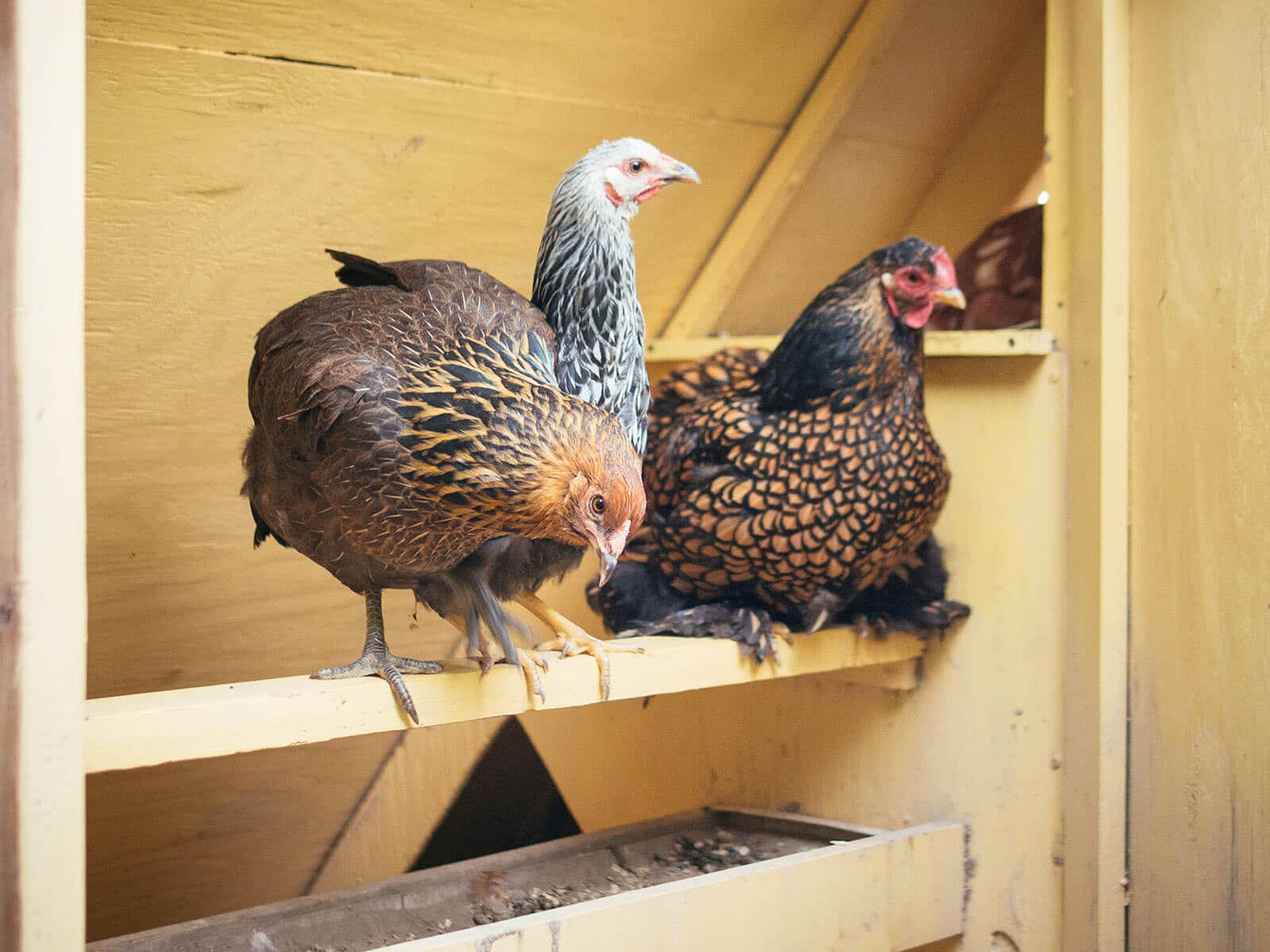
How do you find all the ingredients for homemade chicken feed?
Most of my grains are purchased from Azure Standard. As a natural food co-op that delivers nationwide, Azure Standard carries bulk bags of hard-to-find items like kamut and kelp, and sometimes at a better price than Amazon.
The rest of my ingredients come from local stores with a wide variety of bulk grains. (WinCo Foods was my go-to in Southern California, and still my favorite for cost, selection, and convenience. Market of Choice is my current stop in Central Oregon when I need a last-minute refill or want to try something new.)
You can find more exotic grains at places like Whole Foods Market, Sprouts Farmers Market, and in countless other natural food grocers and bulk food markets.
Your local feed store or grain mill will also carry the basics like oats, wheat, millet, and corn.
Oyster shells and grit are common ingredients found at any feed store or farm/livestock/poultry supplier.
How do you store all the whole grain ingredients?
Whole grains store for a very long time in cool and dark locations. Unless you go through a lot of feed quickly, I wouldn’t suggest keeping the grains in their original bags once opened, because weevils and rodents will think they’ve scored a buffet.
If you have a lot of space or a lot of chickens, you can dump all your ingredients into a clean metal trash can with a lid or a large galvanized steel bucket with a lid, mix them all up, and scoop out from there.
If you lack adequate space or keep a small flock, like I do, you can store the ingredients in airtight bins and mix as you go.
I scoop everything into a flexible bucket, give it a good mix, and pour the fresh food into the feeder. It’s like Christmas Day for the chickens… multiple times a month!
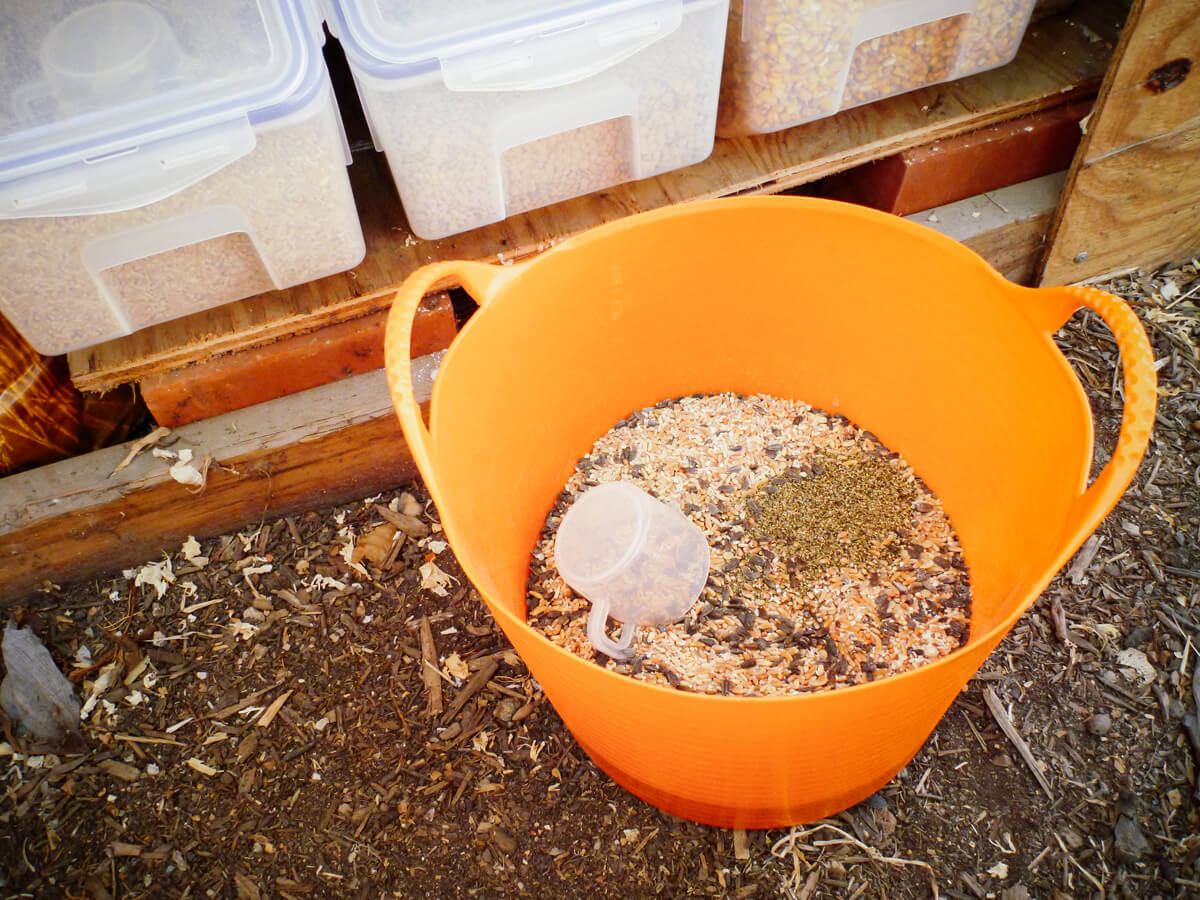
Update: Since this post was originally written, I’ve moved on to a new chicken coop that doesn’t have on-site storage, so I keep all of my grains and seeds in the garage. I’ve also added a few other containers — that I like just as much, if not more than my first containers — which are all linked in my sources at the end of this post.
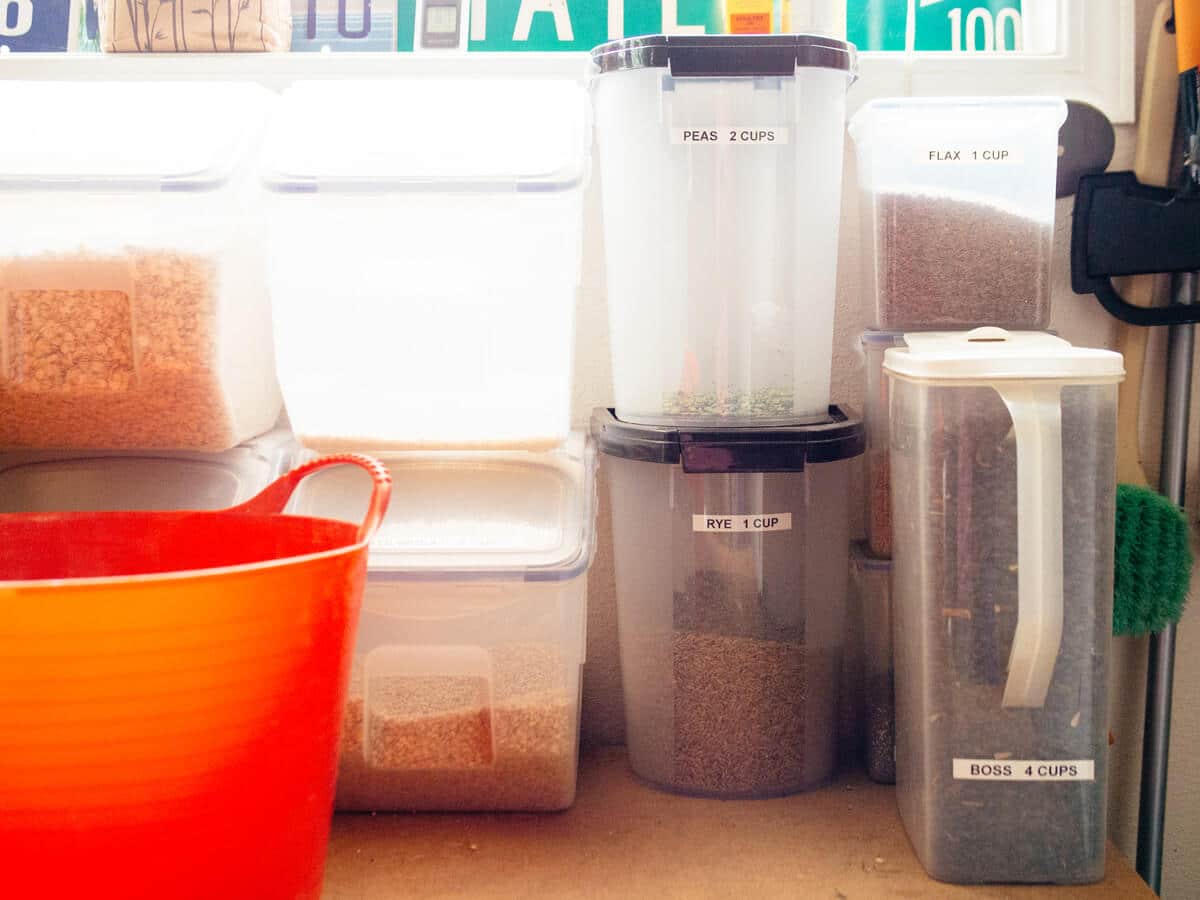
How do you switch a flock from crumbles/pellets to whole grains?
Start by gradually mixing in a little bit of whole grains into your chickens’ current feed to adapt their gizzards.
If they don’t forage frequently, make sure you offer them grit in a separate, free-choice feeder (I use this one).
Chickens don’t have teeth, so they swallow a small amount of grit and store them in their gizzards to grind up food. This is especially important for whole grains that need to be broken down.
Increase the amount of whole grains in their feed each week, until eventually you’re only feeding them whole grains. It may take a few weeks for your chickens to adjust to the change, so don’t be alarmed if egg production drops off a bit.
They may also start flinging grains all over the place (you’ll soon learn what they like and don’t like) or picking out certain grains first. (I believe chickens know what their bodies need nutritionally, so some days they may feed on more protein, less calcium, etc.)
Because of this, it’s a good idea to start with small amounts of different grains and seeds, and see what your chickens will eat before buying in bulk.
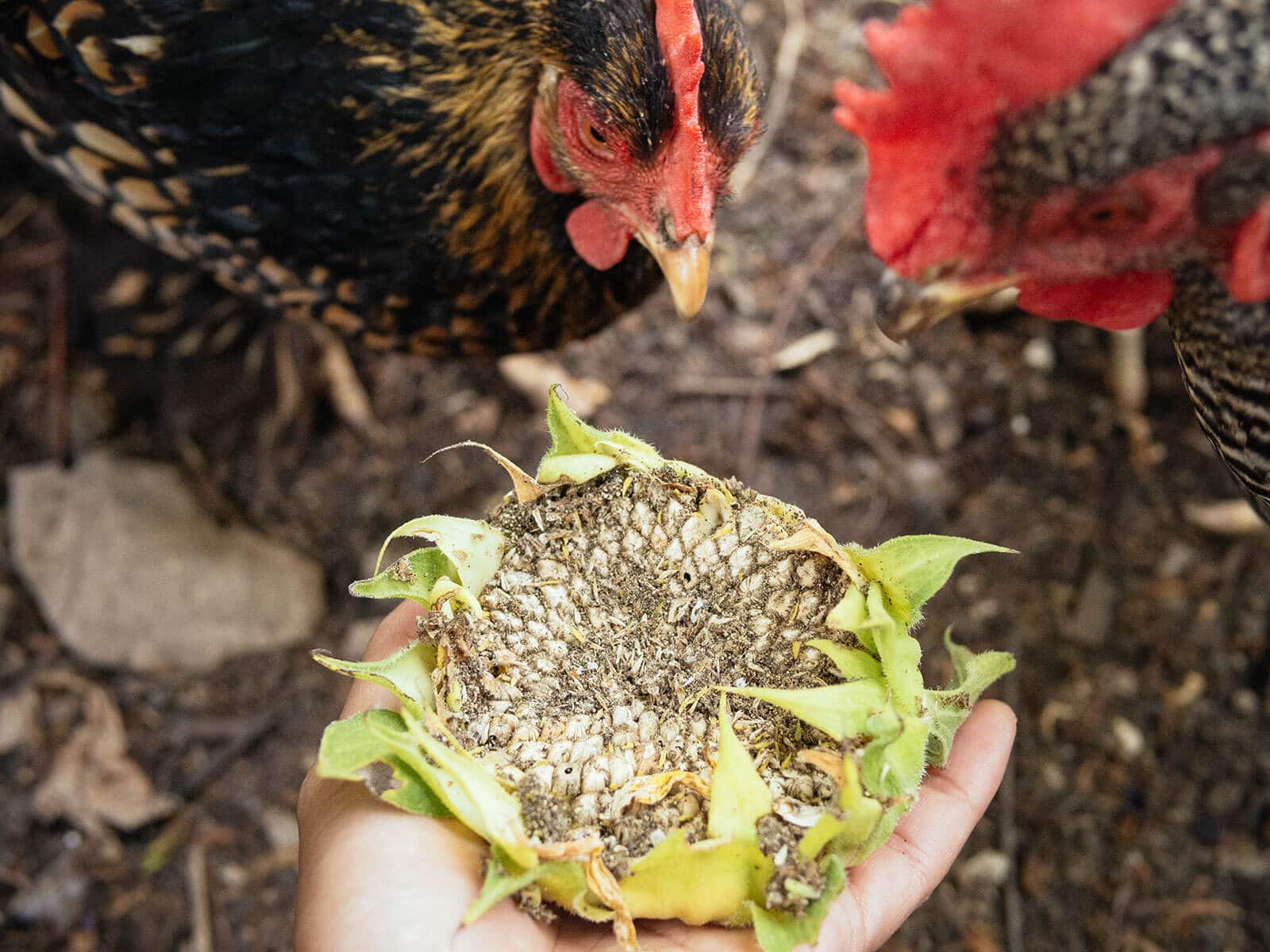
How much protein do chickens need?
My homemade chicken feed is around 17 percent protein, which is in the target range for laying hens.
This is a good number to know if you’re only feeding whole grains. But if you supplement their diet with pasture, scratch, mealworms, and kitchen scraps, all that food will increase (or decrease) the amount of protein they take in each day, so don’t get too hung up on the number.
The cool thing about making your own feed is being able to custom make it for your flock. You can make this chicken feed in bulk if you have a larger flock, just scale the recipe accordingly.
Keep reading for lots of suggestions and alternatives so you can create the best homemade chicken feed for your flock!
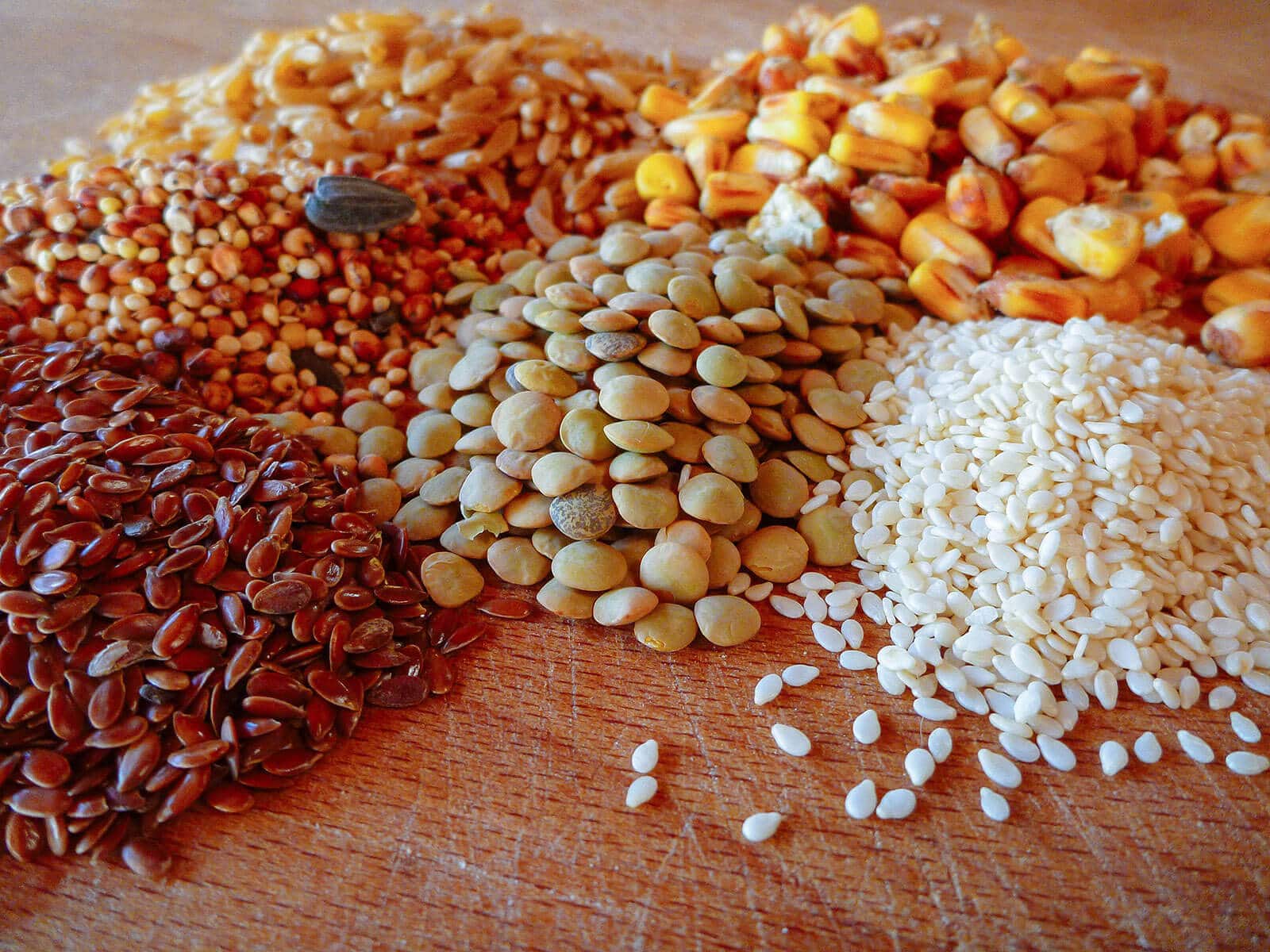
Garden Betty’s Homemade Whole Grain Chicken Feed
Makes 8 1/2 pounds (fills 10-pound feeder)
Ingredients
4 cups oat groats
4 cups black oil sunflower seeds
4 cups hard red wheat berries
2 cups soft white wheat berries
2 cups kamut
2 cups millet
2 cups whole corn
1 cup lentils
1 cup sesame seeds
1 cup flax seeds
1/2 cup brewer’s yeast
1/4 cup kelp granules
Free-choice oyster shells
Free-choice grit
Oats are rich in protein (around 16 percent), B vitamins, calcium and fiber. Oats are also a good (and cheap) source of energy. All oats—no matter how they’re processed—are nutritionally similar, so you can feed oat groats, steel-cut oats, rolled oats, and quick oats interchangeably.
Black oil sunflower seeds (often called BOSS) are like candy to chickens. But good candy! BOSS is high in protein (averaging 17 percent), rich in minerals and vitamins, and the high oil content gives feathers a beautiful gloss. BOSS is typically found in the bird seed aisle at pet and feed stores, and I buy mine from a local farm and garden store. You can also substitute striped sunflower seeds (the seeds that are typically packaged as human snacks), but they tend to be larger than BOSS with thicker shells.
Wheat is a major energy source for chickens. If you can find both varieties, buy hard red wheat and soft white wheat for the best nutritional balance. Otherwise, feed only hard red wheat, as it contains more protein (around 15 percent).
Kamut is actually a brand of khorasan wheat, but these days the grain is simply known as kamut… the way kleenex is synonymous with tissue. It’s an ancient Egyptian grain that’s nutritionally superior to other wheat in terms of protein (18 percent), magnesium, zinc, and vitamin E.
Millet (unhulled) is found in most bird seed, and in fact, the millet I buy is a mix of red and white millet sold at the store as “wild bird food.” It’s less expensive than human-grade hulled millet, but still rich in amino acids and iron. Feed stores sometimes label the unhulled white millet as “proso millet” (not to be confused with spray millet, which is a long and thin seed head).
Whole corn is a fairly large kernel, so depending on your chickens, you may have to crack or grind the corn first. You can also feed popcorn kernels, which are half the size and easier for smaller breeds to pick up. Corn is low in protein, vitamins, and minerals, but it does provide energy and fat (which is especially helpful in winter).
Lentils are very high in protein (at least 26 percent) and if your chickens take to them, it’s worth adding more to your feed. Mine don’t particularly care for lentils or any legumes, for that matter, so I only add a small portion to my feed.
Sesame seeds have one of the highest amounts of protein in a seed (around 25 percent), so they’re especially good for picky chickens that won’t eat legumes. They’re also one of the more expensive ingredients in my feed, so I add them sparingly.
Flax seeds boost omega-3 fatty acids in eggs, and are also rich in protein (37 percent), B vitamins, and minerals.
Brewer’s yeast (animal grade) can be found online or at local feed stores. You can buy human-grade brewer’s yeast too, but you’ll end up paying double (at least). It’s an important source of B vitamins and protein (around 35 percent) for chickens. (On a side note, I’ve also read that feeding brewer’s yeast to your dog will repel ticks and fleas, in addition to providing all the other good stuff.)
Kelp granules (or kelp meal) are basically little bits of dried seaweed. Kelp contains essential vitamins, minerals, amino acids, and salt that your chickens need. It promotes healthy growth, increases egg production, and darkens yolk color—an overall superior supplement.
Oyster shells provide the necessary calcium to strengthen your chickens’ eggshells. Feed this free choice, and they’ll take what they need each day. You can also feed them clean, crushed eggshells to put all that calcium back into their bodies.
Grit is typically limestone or granite gravel that aids the gizzard in grinding food. If your chickens free range, they’ll probably pick up little stones on their own and won’t take as much from the free-choice grit.
Other good sources of protein include triticale, field peas, and split peas (or any peas in general — many soy-free commercial feeds rely on peas to provide sufficient protein).
If money is no object, you could also add quinoa, spelt, wild rice, amaranth seeds, nyjer seeds, hemp seeds, or shelled peanuts as excellent protein sources.
Feeding lower-protein grains like rye, barley, buckwheat, and sorghum (milo) in small amounts will balance the higher-protein (and usually higher-cost) grains.
Try not to make your feed too heavy on any particular grain. The University of Kentucky College of Agriculture offers good information on the pros and cons of common feed grains on their Poultry Extension site.
At the end of the day, if you feed a balanced meal of grains, greens and garden pests—with a little treat here and there—numbers are not as important as a diverse diet.
Where to buy chicken feed supplies
[show_shopthepost_widget id=”3116483″]
Lock & Lock Bulk Storage Bin | Lock & Lock Square Tall Food Storage Container | Buddeez Plastic Storage Container for Pet Food | Iris Nesting Airtight Pet Food Container | Tubtrugs Storage Bucket | Miller Baby Fig Feeder | Little Giant Galvanized Hanging Feeder | AniMed Pure Brewers Yeast | Starwest Botanicals Organic Kelp Granules | Scratch and Peck Feeds Oyster Shell | Scratch and Peck Feeds Grower Grit
Homemade Corn-Free Soy-Free Chicken Feed With Whole Grains
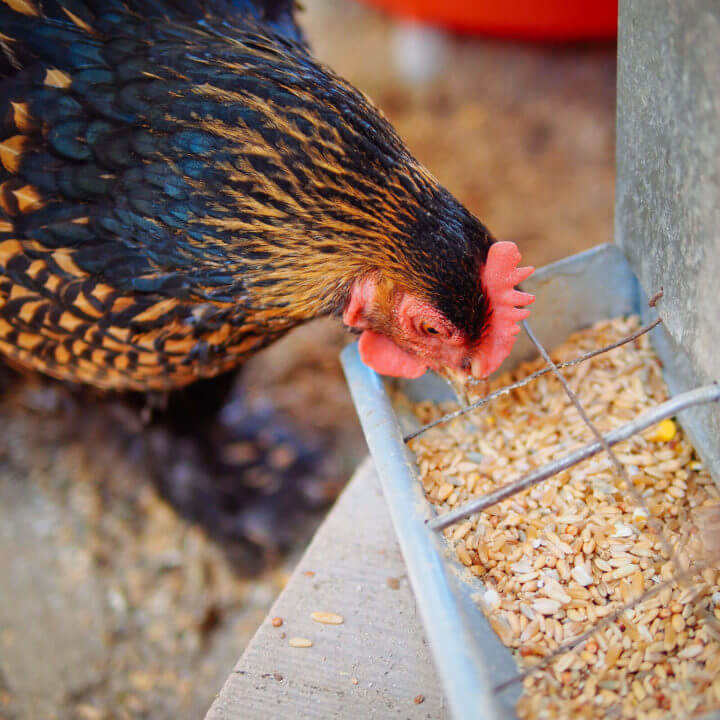
Garden Betty's homemade whole grain chicken feed just got better. This new recipe is corn-free (as well as soy-free) and makes the perfect feed for your favorite layers.
Ingredients
- 4 cups oat groats
- 4 cups black oil sunflower seeds
- 4 cups hard red wheat berries
- 2 cups soft white wheat berries
- 2 cups triticale berries
- 2 cups rye berries
- 2 cups millet
- 2 cups sesame seeds
- 1 cup flax seeds
- 1/2 cup brewer’s yeast
- 1/4 cup kelp granules
- Free-choice oyster shells (or crushed eggshells)
- Free-choice grit
Instructions
- Combine all of the ingredients, except the oyster shells and grit, in a small bucket.
- Fill your feeder with the mixed-grain feed, or store the feed in a pet food container or a galvanized steel bucket with a lid.
- Offer the oyster shells and grit in separate small feeders for your chickens to eat as they wish.
This post updated from an article that originally appeared on June 29, 2012.
View the Web Story on homemade whole-grain chicken feed recipe.



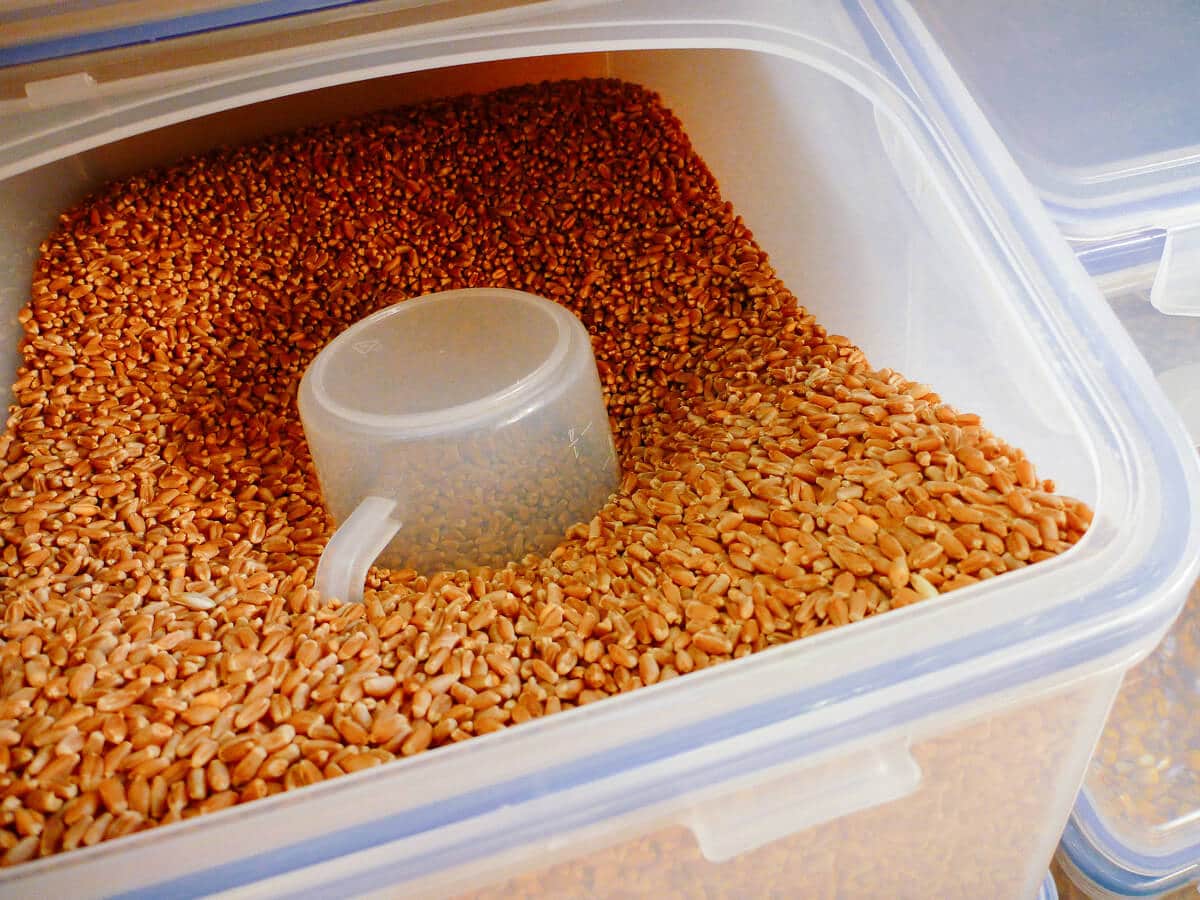
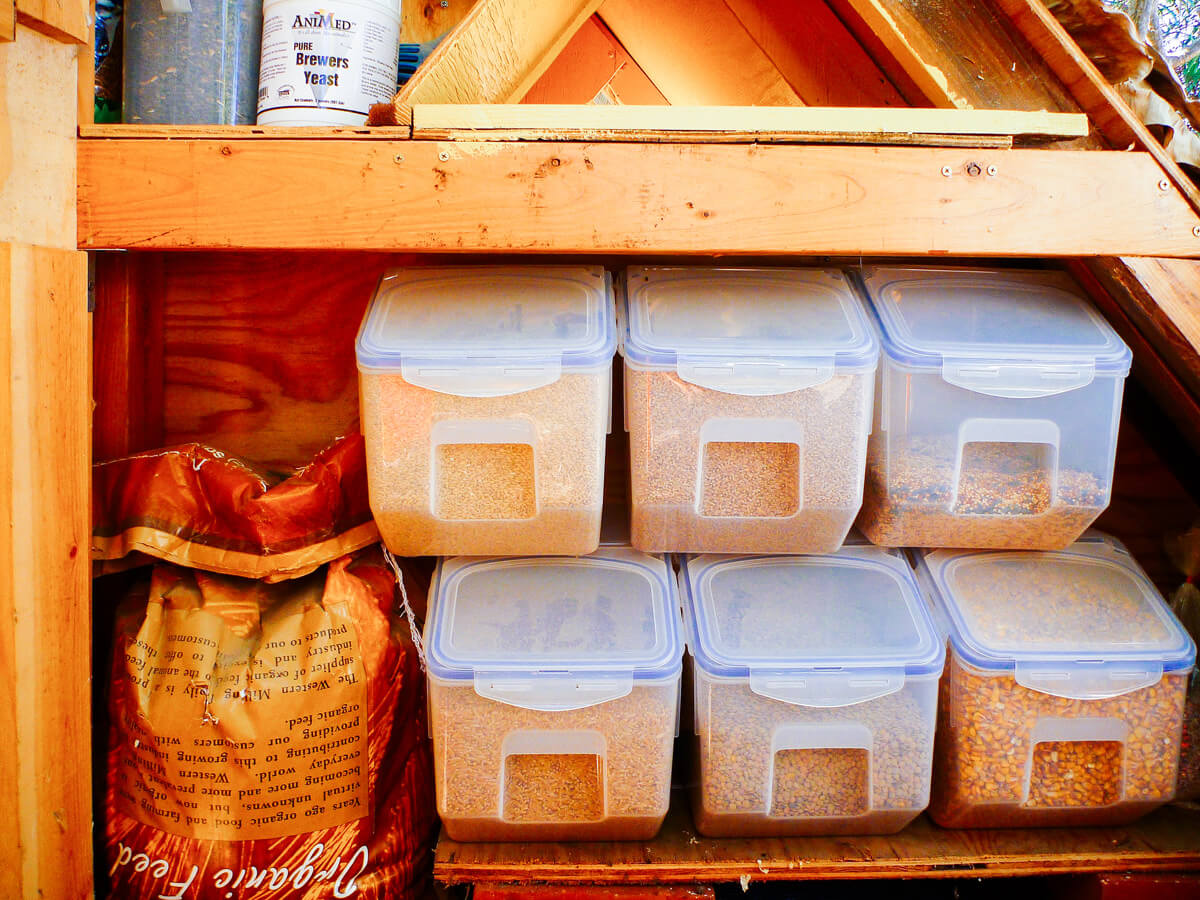
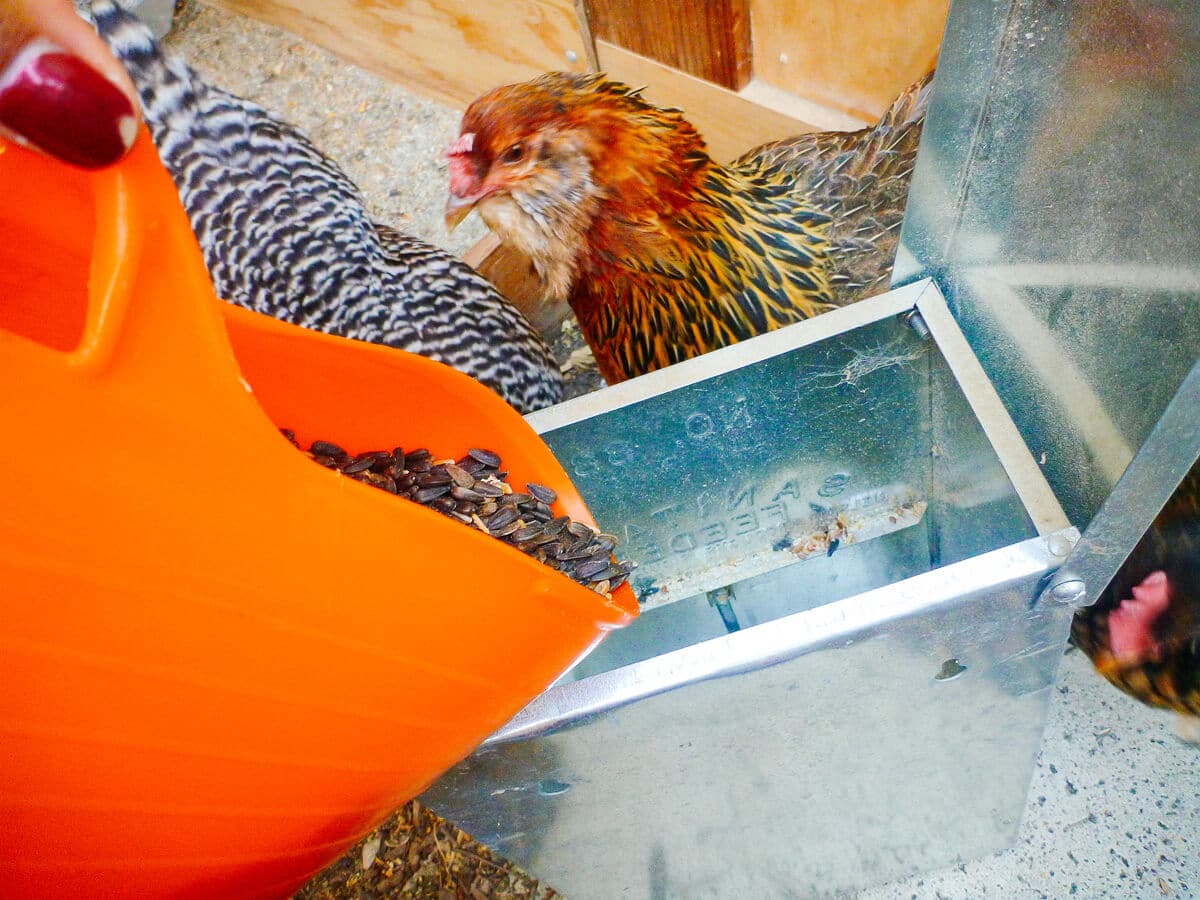













Thank you for the chicken feed recipe and calculator. I just mixed up a large batch including 14.8% amaranth as I had some older grains that needed to be used soon. After I mixed it up, I saw other posts which state you should not feed raw amaranth to chickens due to the anti-nutrients. Can you advise on the use of amaranth?
Or maybe I could cook the feed so as to not waste it?
How about fermented field peas or even dry raw field peas?
Adding fermented peas would improve a bird’s health and vigor, and keep their gut functioning better. We feed a lot of fermented ingredients to out poultry.
I was under the impression that you shouldn’t give raw lentils to chickens??
I have all this stuff in my cart from azure standard and I am seeing $65 for 29 lbs of product, and I will still end to grab a bag of boss for $13. That’s $78 for 39 lbs of feed. Even taking into account the top 3 ingredients are somewhat cheaper, none of them are sold for less than a $1.00/lbs. So I am curious as to your figure of .78/lbs calculation. Was this just a while back and inflation has fluctuated this price point greatly? I’d love to make my own feed if it’s cheaper, but its not adding up that way.
How about feeds for broiler chicken
Wonderful info! Just what I was looking for! I appreciate you listing the benefits of each ingredient and also the extras with expensive feed and lower cost but lower protein choices. You’ve helped empower me to make more informed choices when putting together my homemade chicken feed. I’m excited! And loved seeing how you store all of it. Thanks Linda!
Too cluttered with ads to read. Hurts my head.
Hello, I have a question on using either olive oil or coconut oil in with the whole grain feed to act as a kind of binder so the smaller stuff like kelp and nutri balancer does not settle. It would not have to be too much if mixed thourally. Say with a 50# mixture. What do you think?
If your chickens don’t like lentils, sprout them and feed them. My chickens love sprouted lentils.
I’m struggling to understand the protein percentage for the various grains. I downloaded the handy spreadsheet, but the problem I’m having is the protein percentage in that spreadsheet isn’t consistent with other internet resources or even the “guaranteed analysis” on the grain bags. They often vary quite widely. Which numbers should I trust?
Hi. Thanks for the recipe and for your down to earth approach. May I ask if salt is a necessity if my chicks don’t free range.
This is a great feed for chickens! I love that it is made with whole grains.
Is there a way to make it wheat free? I feel like if soy can get through an egg, so can wheat and I have celiac and haven’t been able to eat eggs on their own for years. I’d love to try a wheat-free version, but it seems the only place that sells one is country organics and it’s $46 for 25lbs lol. I was hoping someone might be able to make a recipe swap for me that would be the same equivelent of wheat but something else.
Hello! Thank you for this, it is so amazing. We are currently feeding our Chickens terrible food from TSC. I am looking forward to making the switch to better food for them and, in-turn, for us. My question is, after tinkering with your calculator, I’m getting about $.84/pound of feed. Scratch and peck, which is already made and is corn and soy free, is $.85. Is there a benefit over using homemade over SandP? It looks pretty identical to me and the cost is almost the same, delivered from Azure. Thanks again!!!!
Where are you getting Scratch and Peck for that price? On their website, the cheapest for whole grain is $85.99 + tax for 50 lbs.
Thank you so much linda
I am so excited to try this and have ordered everything! I have 11 precious chickens with a very defined pecking order. Few questions:
1. How do you keep “queen bees” from picking out the good stuff first and the paupers are left with scraps? I don’t care much from an emotional standpoint -ha!- just concerned that neither set gets complete nutrition? Or one set gets too much fat or protein?
2. In that same vein, I saw the pig feeder you use. I have one similar:) Does the trough part begin to just fill with the little stuff after the good stuff is picked out? This has been my problem with the organic crumbles I use, is the bottom is just filled with dust and they don’t eat it.
3. I read how you ferment (minus brewer’s yeast). That is the simplest way I have ever read! But if you add a fresh cup after a pulling out a fermented cup, could some of the fermented food stay in there too long bc it never gets scooped up? I am sorry if I am overcomplicating this, I just want to get it right!
Do you even realize how expensive this is?? For a big backyard flock this is outrageously expensive. I priced it all out. You’d be better off getting organic bags at the feed store. I love this idea but I think The ingredients are too much to be able to do this money wise.
I did share in my post how much the custom feed cost me per pound, and it’s equivalent to store-bought organic whole-grain feed. This will vary on the availability of grains in your area, and you’ll get a better deal if you buy in bulk (50 lb bags as opposed to smaller portions). But it’s true, sometimes it’s simply more cost-effective and easier to buy commercial feed, especially if you feed pellets or crumbles.
How do you feel about uncooked split peas? Are they good for chickens?
No issues with uncooked split peas. They’re high in protein.
Do you ever feed the liquid from the fermentation to the chickens?
Some of the liquid inevitably ends up at the bottom of their feeding dish, but I find they don’t really drink it the way they drink water. So I just reuse the liquid to start a new batch of fermented feed.
Hey Linda, this feed sounds amazing! I am going to try it. I only have 5 pullets, so i’m trying different things with them. Juts a quick question and you may have answered it already, sorry if you have, but do you cook any of the grains or do you give as is? Thank you.
All the grains and seeds are uncooked. The only time I serve cooked grains is when I make them treats, like hot oatmeal in winter. 🙂
I have read that uncooked lentils are toxic to chickens- that you should always cook lentils ( and rice and beans) first to destroy the toxin
Where can I find your spread sheet??
Im at a total loss here, I have been looking everywhere!
Please leave me a mail as well.
Thank you for all your recipe help!!!
Hi, the link to the spreadsheet is right in the first paragraph of the post. You can also find it here: https://gardenbetty.com/garden-bettys-chicken-feed-calculator-for-determining-your-protein-content/
Hi,
Curious about how you start baby chicks. Do I grind up the feed or should i give it as straight whole grains.
Very much appreciate your blog and input.
You can feed the smaller grains and seeds whole, but grind the larger grains for them. Also, feed chick grit free-choice.
Hi. I just found your recipe for chicken feed and I was wondering about where to find the kelp. Is it possible to get it at a health food store. I have 31 chickens and I want them to have the best food that will help them to stay healthy while they lay their eggs. You can get ahold of me at my email address. Thank you
kelp4less.com is where I purchase my kelp for my garden.
I get my kelp from Azure Standard with the rest of my grains and seeds.
How would I modify this for chicks? Obviously I would grind it up more for them to make it smaller for their mouths. But what do I add to make this more protein for them? I took out the corn and followed your corn free recipe. I came here for The comments since there might be advice for substitute ingredients.
I wanted to transition eventually to gluten free as well. As my children are extremely sensitive to gluten and therefore eggs from chicks that eat it as well. Any suggestions for a gluten free version of this recipe?
Somewhere in the comments are several suggestions for gluten-free substitutes. Some that come to mind immediately are buckwheat, amaranth, hemp seed, nyjer seed, pumpkin seed… I’m sure there’s more, I’m just not very familiar with GF grains. As for adding more protein for chicks, you can download my chicken feed calculator at https://gardenbetty.com/garden-bettys-chicken-feed-calculator-for-determining-your-protein-content/ and play around with the portions to make a higher protein chick feed.
I have been feeding my chickens fermented grains using your soy and corn free recipe. They have thrived and are laying well. My frustration is the eggs are too high in omega 6 oil from the grains and both hands show enlarged knuckles in my pinkies with swelling and pain due to inflammation. I have been high fat low carb grass fed grass finished for over a year. This swelling started shortly after eating my eggs. This is just a heads up and am now looking for other sources of grain reduced ways to feed my chickens. Any suggestions appreciated.
How do you know that they are high in omega-6? Besides the symptoms you have. Could the inflammation be from some other reaction? Also, would increasing omega-3 in the feed work to balance it out? I’m wondering which ingredients are not balanced with their omega-6 & 3 contents.
I can’t dispense medical advice but I can suggest letting your chickens free-range and forage for bugs, weeds, and grasses to supplement their diet. Mine do that and usually don’t eat as much grain in summer (compared to winter, when our landscape is pretty bare).
I will like to maintain a contact with you regarding my feed formula
Hi linda
I have a poultry farm in iran with 40000 laying hens.
I feed pellets to chickens.
Can you suggest a ration according to your formula.???
Thanks
1 cup per chicken per day
1x 40,000= 40000 cups per day
I hope that helps
Going by cups is inaccurate you want to go by lbs as cups always veery in weight. Its 1/4 lb of feed per chicken. So 4 chickens equal 1 lb. So it would be 10000 lbs of feed per day….. lol that’s alot of chickens
Is that dry weight? I ferment my feed so I’m wondering how much I’d feed them of the wet feed
I really appreciate all your ideas and I respect your methods ,,, please i need your help on how i can be doing my homemade feed for chicken… cos here in nigeria i can find all the ingredients…you can reach me on my Email ::
Unfortunately I’m not familiar with what’s available in Nigerian markets or farms.
I am using your spreadsheet, thank you btw, and I was looking up ingredients for certain items and it doesn’t have the nutrients in the guaranteed analysis of the crude percentage that is used on your spreadsheet. It only gives it in grams or in percentage based off a 2000 cal diet. How do I take that information and incorporate into your spreadsheet to get the crude percentage?
Did you ever figure out how to do this? I have the same question.
Hey
Are all lentils okay to feed dry/raw? I have some beluga and some red ones but I’ve seen a lot of people say that all lentils have to be cooked before feeding? What’s your opinion on this?
Hi Melanie, I wanted to ask the same question…
Garden Betty, are your lentils dry in your mix?
I know dried beans are NOT ok.
My girls are loving the mix (it’s sans lentils for now) … Thank you <3
Yes, chickens can eat all lentils raw (uncooked).